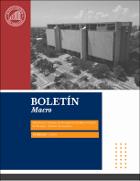| dc.creator | Barrail, Zulma |
| dc.date.accessioned | 2021-01-10T13:53:05Z |
| dc.date.available | 2021-01-10T13:53:05Z |
| dc.date.created | 2019-02-15 |
| dc.date.issued | 2019-02-15 |
| dc.identifier.citation | Ayadi, R., De Groen, W., Sassi I., Mathlouthi W., Rey H., Aubry O. (2016). Banking Business Models Monitor 2015 International Research Centre on Cooperative Finance |
| dc.identifier.citation | Baez, J., Barrail, Z. and Biedermann, G. (2017). Commodity Prices and Business Cycles in Paraguay. Unpublished manuscript. |
| dc.identifier.citation | Fernandez, A., Gonzalez, A., and Rodriguez, D. (2018). Sharing a ride on the commodities roller coaster: Common factors in business cycles of emerging economies. Journal of International Economics, 111:99 121. |
| dc.identifier.citation | Ibarlucia, J., Carrera, J., Bastourrre, D., and Sardi, M. (2013). Global Common Drivers in Emerging Market Spreads and Commodity Prices. The interaction between commodity prices and capital ows. |
| dc.identifier.citation | International Monetary Fund (2008). Paraguay: Sixth and Final Review Under the StandBy Arrangement. Technical report. |
| dc.identifier.citation | International Monetary Fund (2016). Infome del personal tecnico sobre la consulta del articulo IV correspondiente a 2016. Technical report. |
| dc.identifier.citation | Shousha, S. (2016). Macroeconomic E ects of Commodity Booms and Busts: The Role of Financial Frictions. Unpublished manuscript. |
| dc.identifier.uri | http://repositorio.bcp.gov.py/handle/123456789/174 |
| dc.description.abstract | I build a large panel of banks and other financial intermediaries for the period 2006-
2017 to study which business models exist in the Paraguayan financial system using
the statistical methodology of Cluster Analysis. Given the configuration of business
models, I find that systemic banks tend to concentrate in a model based relatively
more on agriculture lending and starting 2011, not only more banks started to switch
to the group of focused agro banks but also the group had on average a significant
increase in foreign debt liabilities. |
| dc.format.extent | 10 páginas |
| dc.format.mimetype | application/pdf |
| dc.language.iso | eng |
| dc.publisher | BCP |
| dc.relation.ispartof | Boletín Macroeconómico |
| dc.relation.ispartofseries | Boletines Macro |
| dc.relation.isversionof | Boletines Macro; N° 7 |
| dc.rights.uri | http://creativecommons.org/publicdomain/zero/1.0/ |
| dc.subject | INDUSTRIA BANCARIA |
| dc.subject | SECTOR FINANCIERO |
| dc.subject | MODELOS DE NEGOCIO BANCARIO |
| dc.subject | PARAGUAY |
| dc.title | Bank business models in Paraguay |
| dc.type | article |
| dc.subject.jel | G10 |
| dc.subject.jel | G20 |
| dc.subject.jel | G21 |
| dc.subject.keyword | BANKING INDUSTRY |
| dc.subject.keyword | FINANCIAL SECTOR |
| dc.subject.keyword | BANK BUSINESS MODELS |
| dc.subject.keyword | PARAGUAY |
| dc.rights.accessRights | Open Access |
| dc.type.spa | Boletín Macroeconómico |
| dc.type.hasversion | Published Version |
| dc.rights.cc | CC0 1.0 Universal |
| dc.rights.spa | Acceso abierto |
 This work is licensed under a Creative Commons Reconocimiento-NoComercial 4.0.This document has been deposited by the author (s) under the following certificate of deposit
This work is licensed under a Creative Commons Reconocimiento-NoComercial 4.0.This document has been deposited by the author (s) under the following certificate of deposit

